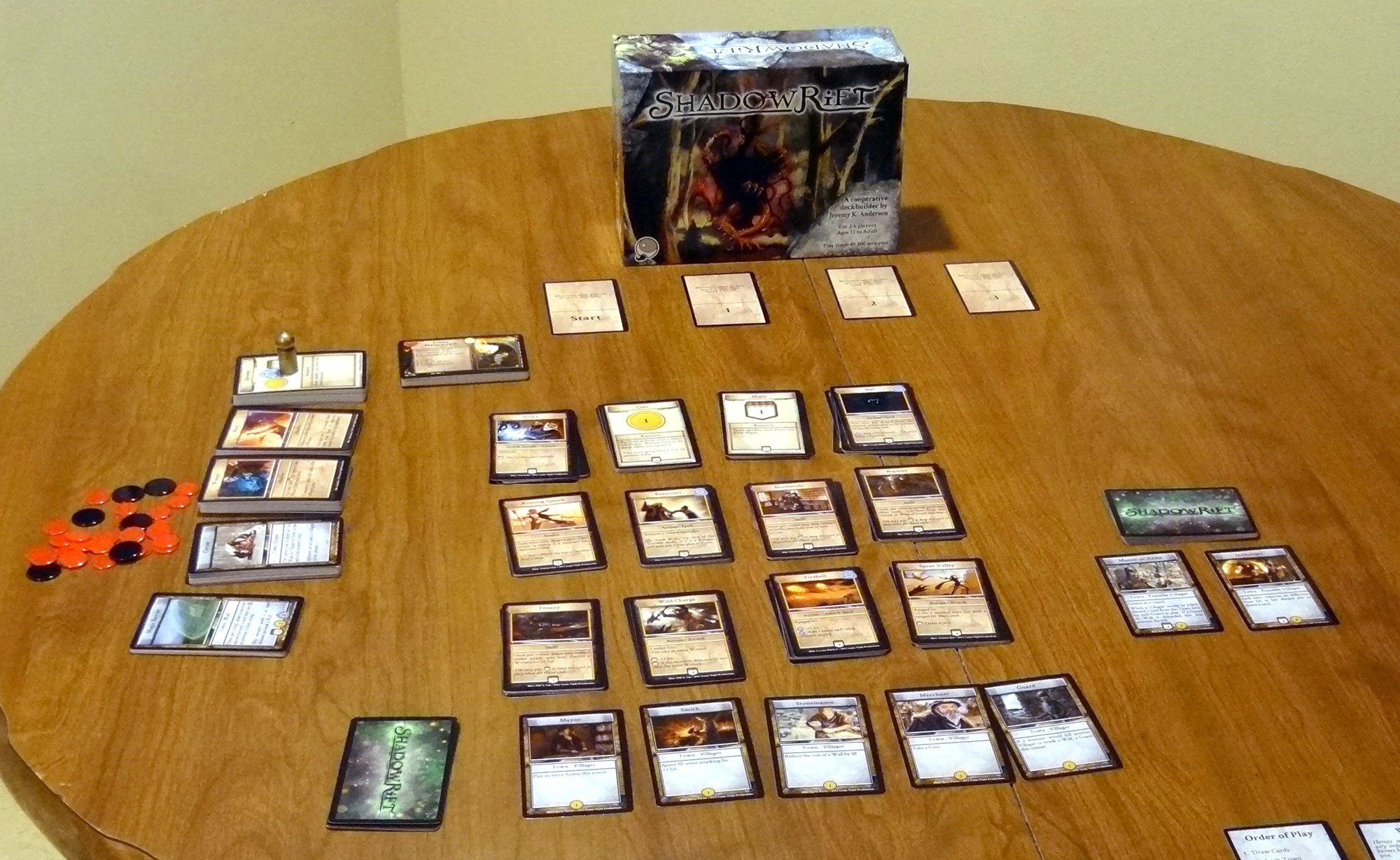
Overview: “Haven Town” is apparently a misnomer, because just outside of town the Shadowrift has opened up, releasing a bunch of nasty monsters bent on destroying the village. The villagers are well-meaning, but they’re simply no match for fire-breathing dragons and spell-casting storm lords. That’s where you come in. Shadowrift is a cooperative deck-builder where the monsters don’t wait for you to come out and fight.
Ages: 12 and up
Playing Time: 40 to 100 minutes (depending on number of players)
Retail: $45
Rating: Terriftic. This unseated Thunderstone as my favorite deck-builder.
Who Will Like It? It’s a combination of deck-building mechanics and a monster-fighting theme, so if you’ve enjoyed games like Thunderstone and Ascension you’ll probably enjoy this one. And if you didn’t like Thunderstone because you felt like there were too many turns where you couldn’t do anything or there wasn’t enough action, Shadowrift addresses some of those issues as well.
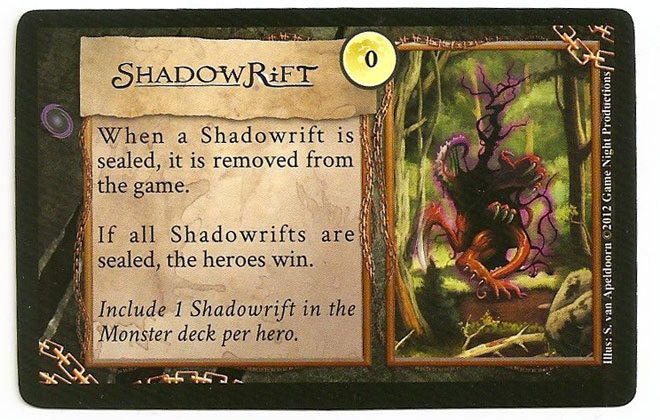
Theme:
The monsters in this game storm into the village and start turning townspeople into corpses. You can’t win by just killing monsters, though, because there is a never-ending supply of them. You’ll have to build up the walls to protect the town, or else seal off the shadowrifts to prevent the monsters from entering our world. The game is a mixture of your typical feudal society (a la Dominion) but with a hefty dose of swords and sorcery as well.
The gameplay really does capture the feeling of being overrun by monsters. When the game first starts up you might not feel like things are too bad, but after a few rounds things really start to get frantic.
Components:
The game primarily consists of cards: 494 of them. Within that you get six different monster classes to fight and a host of actions, skills, loot, and attack cards for the heroes. There are also 25 1-point tokens, 6 5-point tokens, 6 Scenario cards, and 1 Heroism token. The Heroism token is a little plastic gold pawn, and the point tokens are small plastic chips. The Heroism token is fine, but the chips are pretty tiny and a bit flimsy. I’ve taken to using my Penny Gems instead because they’re easier to pick up.

The cards are decent but not great. The printing on some of them is a bit off, as you can see from the scan of the Heroism card to the left. (Maybe a future reprint will fix these?) Game designer Jeremy K. Anderson had the game printed up himself just before Game Salute picked it up for their catalog, so there are some of these inconsistencies and minor flaws that can creep into a self-published game. The rulebook is also a bit lacking and could use an overhaul, but Anderson has been very active on the BGG forums, answering questions and even considering some rules changes in response to fans. I suggest starting with this fan-compiled FAQ thread and then checking out other posts if you have questions.
Aside from that, one nice thing about the cards is that there are color differences in the card backs for cards that don’t get shuffled together. Villagers, infiltrators, and walls are all green; monsters and shadowrifts are red; cards that will go into your deck are blue. The Coin cards, which don’t get shuffled with anything, are sort of gold-tinted. It makes it easy to tell when you’re shuffling if you’ve stuck something in there that doesn’t belong.
The starting cards are marked with a small sword at the bottom instead of the usual prices of the cards but are otherwise similar. It would have been nice to have them stand out a little more, or for Might and Prowess to look a little different so you could notice the difference immediately.
The text on the cards, for the most part, is pretty straightforward and easy to read and understand, and the artwork is excellent, comparable to most other fantasy-style games I’ve played.

Gameplay:
Setup is a little more involved than some deck-builders. (But trust me, it’s worth the effort.) There are six scenarios included, one for each of the monster types, and these include recommended Hero cards for setup. However, once you’re familiar with the game you can pick and choose or do a randomized setup.
As with the others, you’ll have an area in the center with the cards that are available for purchase: in this case, 4 basic card types are included in each game, and then 8 more types complete the set. You’ll also have a stack of Heroism cards, Walls, Wounds, and Corpses. The Heroism token is placed on top of the Heroism deck. You pick one class of monsters, set aside any special cards, and then shuffle in one Shadowrift card per player. There are four cards marked “Start,” “1,” “2,” and “3” which mark the progression of monsters in play.
Finally, there are two decks for the village: one has the original 10 villagers and the other is the deck of Travelers (which includes the Infiltrators). These are each shuffled and kept in two areas. Each player starts with the same ten cards: 7 Prowess, 2 Strike, and 1 Explore. You each shuffle your deck the game begins.
One note: there are three basic resources in the game: Coin, Prowess, and Magic. The Coin cards, unlike money in most deck-building games, do not get shuffled into your deck. They’re placed in front of you, and can be given to another hero at any time — and each Coin can only be spent once, at which time it is returned to the Coin stack. Prowess (which comes on the starting Prowess cards and the Might cards) cannot be shared or pooled with other Heroes to purchase things. Any card with a blue Magic symbol in the top corner can be used either as the Spell action or as one Magic resource to pay for something else. Heroism cards can be used as one of any of the three resources.
The object of the game is to either seal all of the Shadowrifts or to build all eight Walls. You lose if your Town ever contains no Walls or Villagers at the start of the turn or if the entire Corpse deck is exhausted. Also, there are some powerful monsters which can just destroy the world if you let them get too far.

Each round consists of the following phases:
- Draw Cards
- Refresh Town
- Refresh Travelers
- Monsters in Play Act
- Monsters Gain Power
- Add New Monsters
- Heroes Act
(I keep the Turn Order card handy, because even after playing a few times it’s easy to be so eager to get to the Heroes Act phase that I miss things like giving the monsters energy and bringing in new monsters.)
Draw Cards: Each player draws five cards from their own deck. Some cards, like Might and Heroism, immediately allow you to draw another card.
Refresh Town: Discard the current Town cards in play and turn up five new ones, reshuffling if necessary. If there are no Villagers or Walls in the five cards you reveal, then you lose the game. (Or, on the rare occasion when you don’t have five cards to reveal, you lose.)
Refresh Travelers: Discard any current Travelers and reveal the next two. Infiltrators are automatically placed in the Town discard pile.

Monsters in Play Act: If there are any monsters in play, they move to the next available slot and take their actions, from oldest to newest. Monsters from space 3 leave town and the card goes into the Monster Power Area — any hit counters on them are removed and discarded. Each monster has three actions listed — when it enters space 1, it takes the first action, and so on. Some monsters also have an ongoing effect as long as they’re in play.
A few notes on Monster actions: “Activate Powers” means to use any Powers that are present in the Monster Power Area. For instance, the Fire Dragons shown above have a “Rain of Fire” power — if that’s currently in the Monster Power Area and the boss Chorsolesh enters space 1, then you’ll activate the Power. When a monster kills villagers, you remove the villager from play, put it at the bottom of the Traveler deck, and replace it with a Corpse. If the villager isn’t in play, then the monster hunts, flipping over cards from the Town deck until it finds a villager to kill (or a Wall). Finally, if a monster “Rampages,” then that means it doesn’t leave town — it returns back to the Start space as the newest monster during the Add New Monsters phase (but all of its hit tokens stay on the card).
Monsters Gain Power: Add one token per player to the Monster Power Area. In addition, add tokens equal to the number of power icons (on the left side of the monster cards) currently in the Monster Power Area.
Add New Monsters: Each monster card has a cost for it to enter town, represented by the number in the gold circle. Starting with the monster on top of the deck, bring in as many monsters as you can pay for with the tokens in the Monster Power Area. New monsters are placed in the “Start” space — note that they don’t perform any actions this turn, but if they have ongoing effects those will be in play. Some cards like Powers and Shadowrifts have a zero cost and will be moved to the Monster Power Area even if there are no tokens left. Any leftover tokens remain for the next turn.
Heroes Act: Finally, you get to take action. One difference between Shadowrift and many other cooperative games is that everyone can take their actions in any order; you don’t have to have one player take all of their possible actions before another player gets a turn. In fact, it’s usually much more beneficial if you discuss your plan of action because some abilities will depend on who attacked first.
You have several options for actions: Seek Aid in Town, Play an Action, Play a Skill, Play a Loot card, Acquire New Cards.

Each turn, each hero may seek aid from one villager currently in play. You discard the Villager and take the effect shown on the card. It doesn’t cost anything at this time. You can also hire Travelers to come to the town — in that case, pay the cost shown on the bottom of the card and move that Traveler to the Town discard pile. (You don’t get to use the Traveler’s ability at this point.)

Playing actions is straightforward: you play the card and do what it says. You can play any number of Quick Actions as you want, but only one regular Action. Attacks damage a monster of your choice — place a token on the monster representing the damage. When the damage on a monster equals or exceeds its Health (the number in the heart), then you’ve killed it and it goes to the bottom of the Monster deck. Some cards also allow you to pay additional resources (Coin, Prowess, Magic) for an additional effect.
Also, whenever you kill a monster, the Heroes will earn Heroism. The player to kill off the first monster takes the first card, and the next player gets the token. Each time Heroism is earned, the player with the token gets the card and passes the token, so that everyone has roughly the same number of Heroism cards total. (Some monsters are worth more than one Heroism.)
Skills are a special sort of card: you play them in front of you, and you can use the skill printed on the card for that turn. In addition, if you pay 1 Prowess, you can maintain the skill and leave it there for the next turn. Skills can be maintained for as long as you keep paying Prowess. Loot cards are also played in front of you, and they stay there until something specifically discards them. (For instance, the Lightning Daggers are only discarded when you use them in an attack.)
Most cards you acquire will go into your discard pile, with a few exceptions. Coins go in front of you and are immediately available. Walls you build and Travelers you hire are put into the Town discard pile. There are four different types of Walls, two of each type, and they help protect the Town from the monsters.

A few other notes: whenever you play melee attacks on a monster, you will take a Wound — but it’s limited to a single Wound per monster no matter how many melee attacks you play on that monster. Your basic Strike card is a melee attack, but you can also pay 2 Prowess to turn it into a ranged attack to avoid the Wound. Wounds basically dilute your deck, taking up space in your hand, but there are some skills (like Frenzy) which let you use Wounds for beneficial effects. You can remove Wounds by paying 2 Prowess, or with certain other card effects.
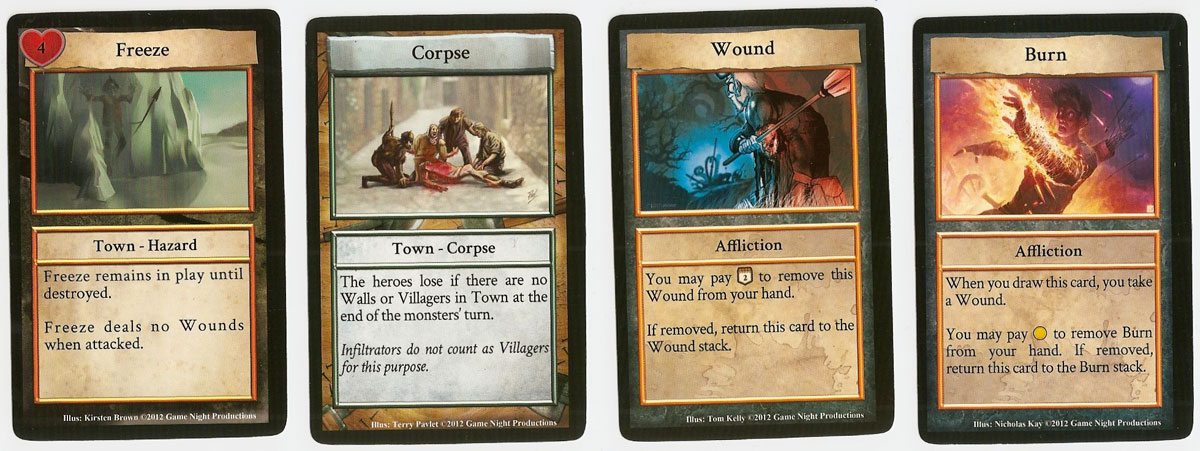
The six monster types included in the game each have their own strengths and types of attack:
Demons: the four Infiltrators in the Traveler deck are replaced with Cultists, who help the Demons come to town more quickly.
Fire Dragons: Among other things, they can cause Burns — and each time you draw a Burn card, you get another Wound. Very bad.
Glacien: They can put Freeze cards in your Town, which stay there (taking up one of the valuable spots) until you smash them.
Drow: These guys build Totems which build up their power and also have to be dealt with before removing other cards from the Monster Power Area.
Necromancers: Corpses turn into Zombies, which quickly add more Corpses to your Town, which turn into Zombies … you get the picture.
Storm Lords: They have their own magic spells which wreak havoc on the Heroes.
Conclusion:
Here’s the short version: Shadowrift is a lot of fun. Yes, the rulebook is a bit of a mess and the tokens are cheap and flimsy. Yes, the box dividers and organization leaves something to be desired. Yes, it’s hard. But it feels like the sort of experience Thunderstone was meant to replicate: a bunch of monsters rampaging through town, with just a small band of heroes to fight them off.
Ok, so I’m not selling my collection of Thunderstone just yet, but here are some of the things that really set Shadowrift apart. The Town and Travelers decks can be a little fiddly — there’s just a lot of different decks to shuffle and refresh and keep track of — but it turns out to be a great mechanic. The Merchant dies, and you take him out of the town and put in a Corpse. Oh, hey, another Merchant is traveling through — you can hire him and add him back to the Town again. The fact that you only turn up five cards each round means that when you’ve had a lot of dead Villagers there’s tension just as you start flipping them over: “Corpse … Corpse … Infiltrator … Freeze … aaaaaaannnndddd … Oh, whew! It’s a Guard. We get another round.”
I also like the fact that the monsters are moving through town, whether you’re ready or not. There’s no sitting around in town, building up your inventory and schmoozing with the locals. Each monster has three different actions, and it’s often a tough decision deciding whether you can afford to let them finish their course of actions and leave town or if you have enough firepower to kill them off. Sometimes it’s not worth attacking a big boss monster because you’ll take so many Wounds — but then they end up in the Monster Power Area, which means that even more monsters will be charging through the gates.
The various scenarios also feel very different. In Thunderstone, your mix of heroes and equipment will depend somewhat on the mix of monsters, but the essential strategy is the same: build yourself up, kill as many monsters as you can. In Shadowrift, the strategies will shift. With the Glacien, you’ll have to decide between attacking monsters and hitting the Freezes before your whole town freezes over. The Drow destroy walls very easily, so you’ll want to focus on the Shadowrifts. But with the Zombies, you’ll have to pay attention to the number of Corpses in town.
The fact that all the heroes play simultaneously also makes for an interesting co-op experience. You still can get the “alpha player” syndrome with Shadowrift if somebody takes the lead and starts telling people what to do, but the fact that each player can take their own actions in any order changes it up a bit. Also, I found that with most other deck-builders people tend to buy a lot of similar things, and that was my approach the first few times we played: get a few spells, some skills, a couple of attacks, and so on. But then we realized that the spells usually require magic to boost them, and attacks require Prowess — if you have a bunch of both then it’s harder to get the necessary cards in one draw. When we split off, with one person becoming the Mage and collecting mostly spells and another taking on a lot of attacks (and Wounds), then it made for a better overall team.
I’ve played against all six monster types, and despite losing many times I always look forward to playing this some more. It really overcomes the common complaint that deck-builders are like multiplayer solitaire, because in this case there’s always something happening each turn. Even if you personally have a hand full of Wounds and can’t do much, you’re part of a team that has to prepare for the next onslaught.
The downside to the game is that it can be a little unbalanced. I think some of the scenarios would work better with a particular number of players: Storm Lords seemed pretty weak against only two players because they were spawning too slowly to start casting a lot of magic. The Demons, on the other hand, overran us in a two-player game very quickly and it wasn’t quite as satisfying. It’ll take me many more plays to feel out whether I just need to hit the right strategies or if some monsters are simply easier than others. For the most part, though, I’ve been enjoying the game each time, with some moments of exhilaration at a perfectly executed chain of attacks and moments of extreme dismay at a hand full of Wounds.
In short: if you like deck-builder games and a bit of monster-slaying action, Shadowrift should be at the top of your list to try out. Pick it up from Amazon, Game Salute, or any Game Salute Select Store.
Disclosure: GeekDad received a review copy of this game.
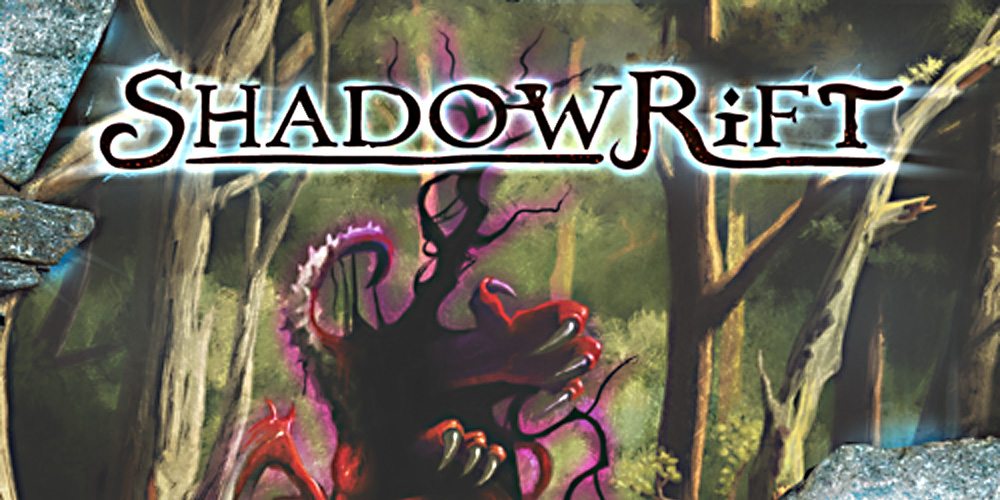
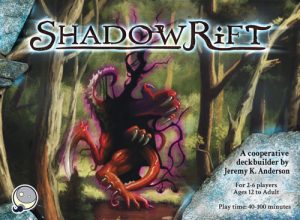

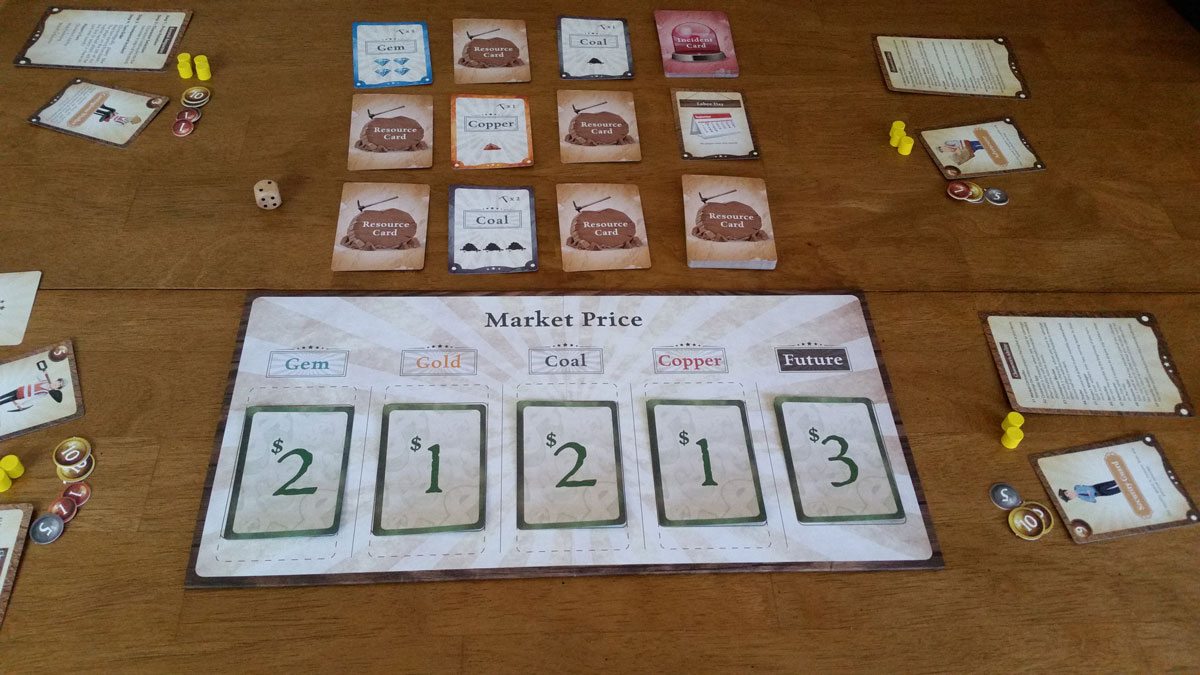
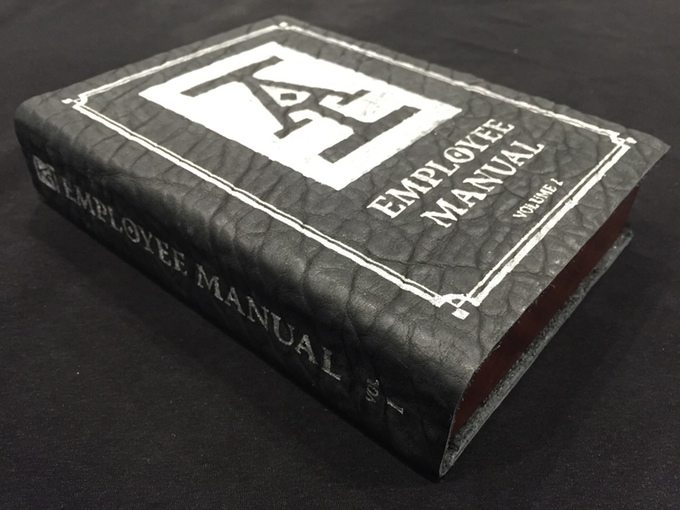

Thanks for another great review. Have you guys thought of doing video reviews or live plays? After reading this, I immediately went and found Rahdo’s runthrough and other video sources. Obviously, more time, but I don’t know how much goes into writing the reviews as well as playing the games.